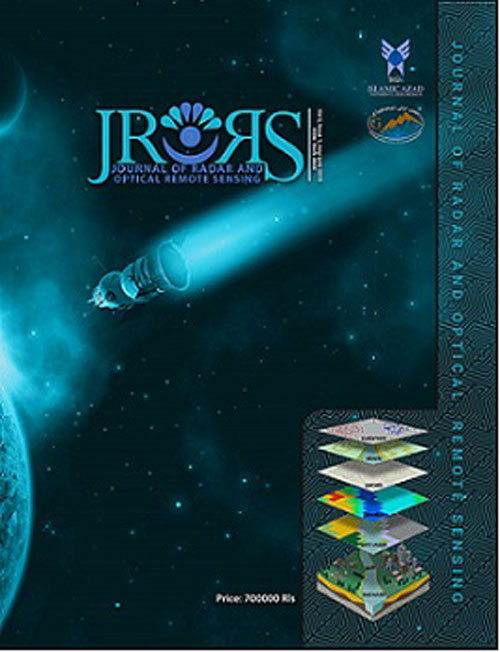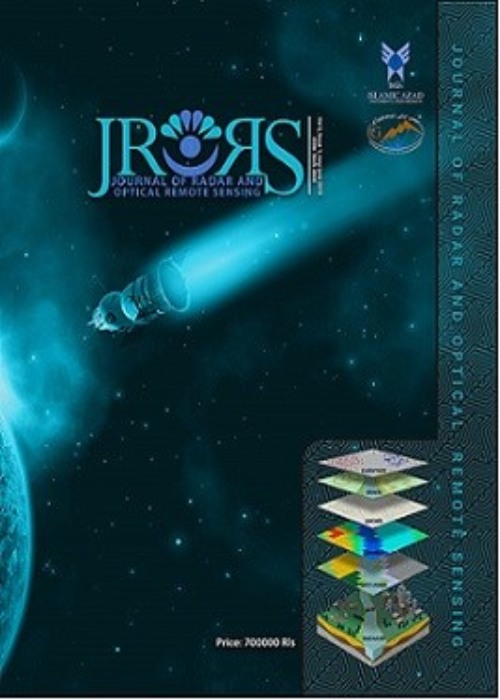فهرست مطالب

Journal of Radar and Optical Remote Sensing
Volume:2 Issue: 3, Summer 2019
- تاریخ انتشار: 1398/09/10
- تعداد عناوین: 6
-
Pages 7-19Natural hazards have always changed the environment and threatened human life. In this regard, geological hazards including earthquake, subsidence, etc. are the most destructive natural factors that our country, Iran, is affected by them. That is why planning and preparation to deal with these catastrophes is essential. Aerial communication networks have an important role in the relief operation because of the rapid access after an earthquake. The purpose of this study, is locating an appropriate site of air rescuing after a casualty. Hierarchical analysis method was used for weighting after determining the effective indicators in locating; including the area of open space of the site, access to dense and vulnerable texture, service user and main arteries. After preparing the final map, zones of avoidance were announced. The evaluation method similarity to ideal option in the software environment of the spatial information system was used to select the final site. This study is an applied research because of its aim and it has been carried out using descriptive - analytical method. According to obtained results, three squares called Sanat, Saheb-a Zaman and Farhang were selected as suitable sites. Sanat square was identified as an appropriate site because of having the highest score according to defined criteriaKeywords: Air Rescue, Spatial Information System, hierarchical analysis, Similarity to Ideal Option, Yazd
-
Pages 20-34
The most important radioactive elements are the solid crust of uranium and thorium. The various isotopes of these elements with a long decay chain and the production of other radioactive elements become stable elements. Shirkooh granite with a melting source has a spread of more than 1,000 square kilometers and includes chronology of the first formations of geology to the present. According to measurements of water, soil and rock radionuclides, Shirkooh granite contains radioactive elements U and Th. In order to investigate the Shirkooh range, Landsat satellite images have been used for the expansion of radioactive elements. Also, 30 specimens with a specific radioactive content have been subjected to spectral sampling by a Philadelphia device and a spectral library has been prepared. In this research, areas with the highest concentration of radioactive elements were determined using spectral angle mapping and supervised classification. The results show that samples with the highest amount of uranium and thorium are located in three regions including west and south of Manshad and southern of Tezerzan.
Keywords: Landsat, Shirkooh, spectrometry, Radioactive -
Pages 35-43One of the major strengths resulting from hyperspectral imaging is target detection, specifically subpixel detection, which is generally carried out without full knowledge of the targets to be detected. The aim of this study is to design and develope a hyperspectral camera and then testing its results in hidden target detection domain. For this purpose, a coin was hidden under a cloth in a laboratory environment and then was take hyperspectral imaging of the hidden target. Initially, the images were labeled in terms of wavelength and band and geometric corrections and used for final processing. In order to detect image anomalies, the RX algorithm was used locally to identify pixels that are spectrally different from other pixels. To identify hidden target material, spectra of extracted as anomalies pixels were extracted and by using of the spectral library, hidden target material was identified. The accuracy of the extracted spectra was evaluated by the spectral angle, ACE , Likelihood and FP correlation methods and the results showed high accuracy of the target material identification process.Keywords: hyperspectral camera, hidden target detection, Anomaly, RX algorithm, Accuracy assessment
-
Pages 44-54
Qeshm salt dome is a part of Qeshm unique Geopark, the only Geopark in the Middle East. The present study is a descriptive-analytical. Qeshm Salt Dome study area and required information for this research are radar satellite images, optical satellite images as well as rock, geological information of the area using radar interferometry and paired radar images taken from the site. The European Space Agency is first developing some ground-level models for the region by doing some processing. After constructing the elevation model, the Envi software performs several measurements on the ASAR satellite Envisat satellite radar data and performs interpolation to calculate the elevation of Qeshm Island and presents the results digitally. An adaptive filter was used to provide better results. Rate of salt dome changes in the period 2003-2005, 0 to 0.16 m, in the period 2005-2008, -0.03 to 0.085 m and in the period 2008 to 2010, -0.007 to 0.082 m was calculated. Rate of changes in Qeshm Island in the period 2005-2003, 0 to 0.23 m, in the period 2008-2005, -0.2 to 0.15 m and in the period 2010-2008, were -0.03 to 0.23 centimeter
Keywords: Salt Dome, Qeshm Island, Diapirism, Radar interferometry, Envisat -
Pages 55-62
Nowadays, given the growing trend of population and population density in urban areas especially in densely populated cities and in terms of seismicity, the need for a comprehensive and comprehensive approach to natural and catastrophic events resulting from their occurrence has become more apparent. In this study, District 8 of Tabriz was selected as a case study. The research method is descriptive-analytical, The purpose of this study is to evaluate and model for predicting seismic vulnerability based on physical-spatial indices of Tabriz Considering the quality criteria and providing a suitable model and model for construction in Tabriz, For this purpose, out of 9 criteria, building density, population density, quality of buildings (accessibility), access to pedestrian networks, access to essentials, access to open and green spaces, land use, size of fragments, and distance. Dangerous centers have been used. Necessary statistical data is collected, then layers are prepared for seismic zoning and weighting to layers is done according to zoning standards, the final analysis was performed using the combination of AHP and Fuzzy TOPSIS methods in GIS (proposed method). Finally, the risk level of the study area was obtained from Tabriz city. The results show that the northern areas have the highest risk areas and the southern areas have the least rate, and finally it is concluded that the proposed model for risk zoning is applicable.
Keywords: zoning, Earthquake, Tabriz, fuzzy logic, Multi Criteria Decision Making Models -
Pages 76-87
Solid waste production has been a major problem in human societies in recent decades. Changes in consumption patterns have imposed great problems and costs on large cities to dispose the waste. Today, the geographic information system is considered due to the possibility of analyzing a huge volume of information layers, which has been used in this study to investigate the current stations and improve them. National and international experiences, three layers of the population, land use and access route have been selected. The hierarchical analysis method has been used to weigh the criteria and Landsat images of Shiraz have been used to locate the stations. According to experts, the covered population with the weight of 0.540 has the highest value, land use with 0.297has the next priority and access route with 0.163 is used to improve the collection stations for home recycling materials in Shiraz, based on the population in 1396. Assuming that 50% of the city's population delivered their recycled materials to the stations, 61 stations were located using Landsat images, of which 16 stations with a short distance (300 meters) from the current station were shown. Twenty-one medium-distance stations (300-700 meters) and 24 long-distance stations (more than 700 meters) were identified. In areas with long-distance stations, it is necessary to build and add drop-off centers, collecting recycled materials
Keywords: hierarchical analysis, Geographic Information System, Recycling, Landsat, drop-off centers, Shiraz


